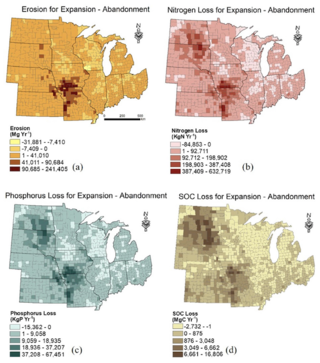
The past 15 years have seen an expansion of agricultural land in the United States, largely driven by increasing corn and soy cultivation. Much of that new farmland comes at the cost of converting grasslands, such as Midwestern pastures and prairies.
Previous studies have shown that such land use changes can impact measures of soil, water, and air quality. Two recent studies conducted more comprehensive analyses of the environmental impacts of grassland conversion to cropland in the U.S. Midwest, led by a team of researchers from the U.S. Environmental Protection Agency (EPA), the Great Lakes Bioenergy Research Center (GLBRC) based at the University of Wisconsin–Madison, and the University of Maryland.

“Expanding cropland area has an outsized negative impact on farmers' soil, water quality, and carbon storage,” says Tyler Lark, a researcher with the GLBRC and UW–Madison’s Nelson Institute of Environmental Studies. “However, restoring current marginal croplands to perennial grasses can immediately begin to reverse and improve these trends, thereby offering a clear solution and pathway to improve agricultural sustainability.”
What did the researchers do?
- The team simulated a host of environmental impacts from the conversion of more than 2 million hectares of grassland—a cumulative area roughly the size of New Jersey—to corn and soy production in 12 Midwestern states between 2008–2016. These 12 states collectively account for more than 80% of the country’s corn and soy production.
- With the Environmental Policy Integrated Climate (EPIC) agroecosystem model, the researchers assessed effects of conversion on nutrient cycling, soil erosion, soil carbon, and more.
- In a second study, researchers focused on water quality in the Missouri River Basin, using the USDA’s Soil and Water Assessment Tool (SWAT) to evaluate nutrient loss in three grassland conversion scenarios: to continuous corn, to a corn/soybean rotation, and to a corn/wheat rotation.
- Several “hotspots” within the Missouri River Basin contributed disproportionately high amounts of nitrogen and phosphorus pollution into the watershed and offer promising sites for targeted mitigation or grassland reestablishment.
What did they learn?

- Net cropland in the studied 12-state area increased by 2.5%. This conversion increased annual soil erosion by 7.9%, nitrogen loss by 3.7%, and soil organic carbon by 5.6% relative to existing cropland.
- The magnitude of the environmental impacts varied greatly depending on the crop and tillage practices. For example, tilled corn and corn-soy fields had 4 to 6 times as much soil erosion and 6 to 10 times as much nitrogen loss as grassland. No-till cropping systems resulted in smaller losses of soil and nutrients. In economic terms, the researchers estimated that the increases in soil erosion alone could lead to $169 million in environmental damage each year.
What do the findings mean?
- Recent grassland conversion to annual cropping systems has negative environmental effects that, while a small part of the overall impact of Midwestern agriculture, add strain to already stressed ecosystems, further exacerbating soil and water quality issues in the region.
“This work highlights the benefits that could be achieved if existing marginal croplands were restored to perennial grasses, including those useful for cellulosic biofuel feedstock production."
Tyler Lark
- These environmental estimates should help land managers and decision makers understand the effects of land policies and practices and help design mitigation strategies. For example, reducing tillage and increasing plant cover promote soil conservation, reducing fertilizer use can reduce pollution of waterways, and a shift from annual crops to perennials usually sequesters additional carbon from the air into the soil.
- Corn and soybeans are currently the two dominant biofuel crops. Greater utilization of perennials, such as switchgrass or other native grasses, as alternative biofuel feedstocks could substantially improve environmental outcomes.
Read the papers:
Zhang X, et al. Grassland-to-cropland conversion increased soil, nutrient, and carbon losses in the US Midwest between 2008 and 2016. Environmental Research Letters. (2021) 16: 054018. Doi: 10.1088/1748-9326/abecbe.
Chen P, et al. Assessing the impacts of recent crop expansion on water quality in the Missouri River Basin using the soil and water assessment tool. Journal of Advances in Modeling Earth Systems. (2021) 13: e2020MS002284. Doi: 10.1029/2020MS002284.